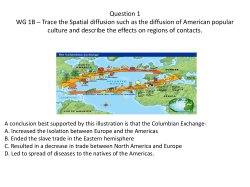
Lesson 2 Biomes (watch pole to pole at end of lesson)
Lesson 2 Biomes (watch pole to pole at end of lesson) Warm Up 1. Define the following terms : a. abiotic b. biotic c. biome 2. List the 8 terrestrial biomes of the world . i. v. ii. vi. iii. vii. iv. viii. 3. Name the two abiotic factors that influence the characteristics of biomes. The biosphere is the thin layer of air, land, and water at Earth’s surface where living things exist. A biome is a large area of the biosphere that has characteristic climate (longterm weather conditions in an area, including rainfall and temperature), plants, and animals Examples of biomes include aquatic (related to water) biomes, such as the tropical ocean, and terrestrial (related to land) biomes, such as desert, tropical rainforest, and permanent ice. Biomes are classified based on many qualities, such as water availability, temperature, and interactions between biotic and abiotic factors. • Biotic factors are all organisms in the environment, including bacteria, plants, and animals. • Abiotic factors are all nonliving parts of the environment, such as air, water, soil, light, and temperature. Identify each of the following as either a biotic or an abiotic factor. (a) crab (b) ocean temperature (c) lake water (d) dissolved oxygen (e) tides (f ) seaweed 1 Biomes of the World Biomes of Canada 2 Biomes of the world Tropical Rain Forest found near the equator have temperatures of 20°C to 25°C yearround, receive about 250 cm of rainfall per year have a dark forest floor that limits plant growth there have plants and animals that survive in warm, wet environments. Temperate Rain Forest Location: 38° to 61° north latitude, along coast of British Columbia Climate: more than 200 cm precipitation per year average temperatures 5°C to 25°C Physical Features: biome occurs in narrow strips along coastlines backed by mountains where ocean winds drop large amounts of moisture on windward side of mountains Boreal Forest (Taiga) Location: 45° to 65° north latitude Climate: precipitation, mostly snow, is 30 cm to 85 cm annually; temperatures are below freezing half the year Physical Features: short summer growing season; terrain is rough, soil is wet; many marshes, shallow lakes, and wetlands Temperate Deciduous Forest Location: eastern Canada, above 23.5° north latitude Climate: annual precipitation is 75 cm to 180 cm temperatures range from −30°C winter to 30°C summer Physical Features: four distinct seasons; long, warm growing season; soil is enriched by fallen leaves; large seasonal changes between summer and winter Grassland (temperate grasslands or prairies) Location: above 23.5° north latitude Climate: 25 cm to 100 cm precipitation annually; hot summers of 30°C and cold winters below −10°C Physical Features: land is mainly flat and soil is very rich and fertile strong winds may cause soil erosion Desert Hot deserts are found on every continent at about 30° north and south latitude have hot days with cold nights receive less than 25 cm of precipitation per year have soil that is salty, have plants and animals that are able to live there because they can prevent water loss through their leaves or skin. Tundra Location: 60° to 70° north latitude Climate: less than 25 cm precipitation annually Summer temperatures: 3°C to 12°C Winter temperatures: −20°C to −30°C Physical Features: flat layer of permafrost (permanently frozen soil) poor drainage marshy in summer 24 h daylight in brief summer; cold and dark in long winter Permanent Ice Permanent ice biomes are found near the poles have very strong winds receive less than 50 cm of precipitation a year, have very cold winter temperatures have animals that have thick coats and fat layers for warmth. 3 Adaptations Biomes are often identified with characteristic biotic factors, such as cactus in the desert or caribou on the tundra. Many characteristic biotic factors have special adaptations for that biome. An adaptation is a characteristic that allows an organism to better survive and reproduce. There are three types of adaptations: Structural adaptation—a physical feature that helps an organism survive. For example, a wolf has large paws to help it run in snow. Physiological adaptation—a physical or chemical event inside the body of an organism that allows it to survive. For example, a wolf maintains a constant body temperature. Behavioural adaptation—a behaviour that helps an organism to survive. For example, wolves hunt in packs to capture large prey. 4 Practice Questions 1. What is the most striking similarity between the tundra and the desert? 2. What do you think makes the tundra’s ecology so fragile? 3. Fill in the below graph with the correct biome in the correct box. 4. Use your phone(or computer at home) to perform the following task a. Research 1 plant/animal that is found predominantly in each biome of Canada (so you will research a total of 5 species) (example: The polar bear is found predominantly in the tundra biome) Give an adaptation that the species has to help it survive in the biome (example: the polar bear has hollow hairs to help insulate it in the cold temperatures) Identify the adaptation as structural, physiological or behavioral (example: hollow hairs are a structural adaptation) you must have at least one of each type of adaptation 5
© Copyright 2025













